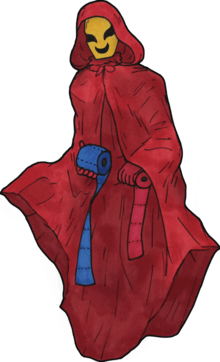Aka Manto
Aka Manto (赤マント, Red Cloak),[1] also known as Red Cape,[2] Red Vest,[1] Akai-Kami-Aoi-Kami (赤い紙青い紙, Red Paper, Blue Paper),[3] or occasionally Aoi Manto (青マント, Blue Cloak),[3] is a Japanese urban legend about a masked spirit who wears a red cloak, and who appears to people using toilets in public or school bathrooms.[3] Accounts of the legend vary, but one consistent element of the story is that the spirit will ask the occupant of a toilet a question. In some versions, he will ask if they want red paper or blue paper, though other versions identify the choices as a red cloak or a blue cloak, or as a red cape or a blue cape. Choosing either option will result in the individual being killed, so the individual must ignore the spirit, run away, or reject both options in order to survive.

The legend and its variations
Aka Manto is described as a male spirit, ghost, or yōkai who haunts public or school bathrooms.[4] Aka Manto is often said to haunt female bathrooms specifically, and in some versions of the legend, he is said to haunt the last stall in such bathrooms.[4] The spirit is said to wear a flowing red cloak and a mask which hides his face, and is sometimes described as being handsome and charming beneath his mask.[3][4]
According to legend, if a person is sitting on a toilet in a public or school bathroom, Aka Manto may appear, and will ask them if they want red paper or blue paper.[3][5] Depending on the version of the story, the spirit may ask them to choose between a red cloak and a blue cloak,[6] or between a red cape and a blue cape. If they choose the "red" option, they will be lacerated in such a manner that their dead body will be drenched in their own blood.[7] The specific manner in which the person is lacerated differs depending on the account of the legend, including the person being stabbed or flayed.[1] If the individual chooses the "blue" option, the consequences range from that person being strangled to all of the person's blood being drained from their body.[8]
If an individual attempts to outsmart Aka Manto by asking for a different color of paper, cloak or cape, it is often said that they will be dragged to an underworld or hell as a result.[9][10] In some versions, choosing a "yellow" paper, cloak or cape will result in the occupant's head being forced into the toilet.[1][11] Ignoring the spirit, or replying that one does not want or prefer either kind of paper, is said to make the spirit go away.[11] In some accounts, rejecting both options and running away from Aka Manto will also result in the individual's survival, although sometimes Aka Manto will simply block the exit.[1]
History
Author and folklorist Matthew Meyer has stated that the Aka Manto has been recorded as a schoolyard rumor dating back as early as the 1930s.[1] In that time, the word manto commonly referred to a sleeveless kimono-style jacket, whereas in the modern day, manto is the Japanese word for cloak or cape.[1] Because of this, different generations have had differing views of Aka Manto's supposed physical appearance.[1]
In popular culture
The 2003 video game Castlevania: Aria of Sorrow features an enemy known as "Killer Mantle", which may have been based on the Aka Manto legend.[12]
The 2019 video game Aka Manto, developed and published by Chilla's Art, is based on the legend.[13][14]
See also
- Akaname, a Japanese yōkai said to lick the filth in bathrooms and bathtubs
- Hanako-san, a Japanese urban legend about the spirit of a young girl who haunts school bathrooms
- Kuchisake-onna ("Slit-Mouthed Woman"), a Japanese urban legend about a disfigured woman
- Teke Teke, a Japanese urban legend about the spirit of a girl with no legs.
References
- Meyer, Matthew (31 October 2016). "Aka manto". Yokai.com. Retrieved 12 July 2019.
- "Japanese Scary Stories: Aka Manto". Japan Info. Japan Info Co., Ltd. 11 June 2015. Retrieved 7 August 2019.
- Grundhauser, Eric (2 October 2017). "Get to Know Your Japanese Bathroom Ghosts". Atlas Obscura. Retrieved 12 July 2019.
- Bathroom Readers' Institute 2017, p. 390.
- Joly 2012, p. 55.
- Briggs, Stacia; Connor, Siofra (16 June 2018). "Weird Norfolk: The haunting of Hardley crossroads". Eastern Daily Press. Retrieved 7 August 2019.
- Vago, Mike (15 May 2016). "Don't fall for Japan's urban legends". The A.V. Club. Retrieved 12 July 2019.
- "トイレの花子さんは時代遅れ? いまどきの学校の怪談とは" [Is Hanako-san in the toilet obsolete? What is the ghost story of the school of today?] (in Japanese). 18 June 2014. Retrieved 12 July 2019.
- Yoda & Alt 2013, p. 237.
- Bricken, Rob (19 July 2016). "14 Terrifying Japanese Monsters, Myths And Spirits". Kotaku. Retrieved 12 July 2019.
- Bathroom Readers' Institute 2017, p. 391.
- Gilbert, Brian David (25 November 2018). "I wasted 3 weeks of my life finding Castlevania's hottest monster - Unraveled". YouTube. Polygon. Retrieved 21 September 2019.
- "Aka Manto | 赤マント on Steam". Steam. Retrieved 29 July 2020.
- Shohei, Hay (20 February 2020). "『事故物件』『赤マント』『雪女』。Steamで話題の兄弟ホラーゲームクリエイター"Chilla's Art(チラズアート)"インタビュー。なぜレトロ和風ホラーを作り続けるのか". Famitsu (in Japanese). Retrieved 29 July 2020.
Bibliography
- Bathroom Readers' Institute (2017). Uncle John's OLD FAITHFUL 30th Anniversary Bathroom Reader (Uncle John's Bathroom Reader Annual). Portable Press. ISBN 978-1684120864.CS1 maint: ref=harv (link)
- Joly, Dom (2012). Scary Monsters and Super Creeps: In Search of the World's Most Hideous Beasts. Simon & Schuster. ISBN 978-0857207647.CS1 maint: ref=harv (link)
- Yoda, Hiroko; Alt, Matt (2013). Yokai Attack!: The Japanese Monster Survival Guide. Tuttle Publishing. ISBN 978-1462908837.CS1 maint: ref=harv (link)
Further reading
- 文芸 [Literature] (in Japanese). 21. 河出書房新社 (Kawade Shobo Shinsha). 1982.CS1 maint: ref=harv (link)
- Tanemura, Tokihiro (1989). 日本怪談集 [Japan ghost story collection] (in Japanese). 1. 河出書房新社 (Kawade Shobo Shinsha).CS1 maint: ref=harv (link)
